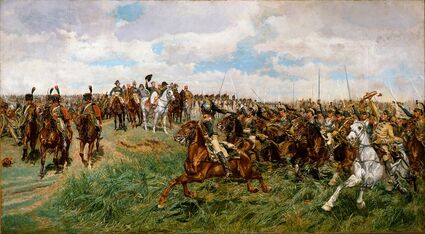Rioni Civil War
| Rioni Civil War | ||||||||
|---|---|---|---|---|---|---|---|---|
 Separatist troops during the Kenderes Campaign | ||||||||
| ||||||||
| Belligerents | ||||||||
|
|
|
Hayren Khanate Principality of Chryse
| ||||||
| Commanders and leaders | ||||||||
|
Trayko Boikov Baligov Damyan Desislavov Alexov Bálint Vince Miksa Izabella |
Andrea Prohászka Dijana Dubravac Alexander Balla Neven Brzica Vince Somogyi Anamarija Varga | |||||||
| Strength | ||||||||
| 500,000 (peak) | 600,000 (peak) | Varied | ||||||
| Casualties and losses | ||||||||
| ~400,000 killed | ~500,000 killed | Unknown | ||||||
| Total Casualties: 1-2 million killed, wounded, and missing | ||||||||
The Rioni Civil War was a multi-party civil war fought predominantly between forces loyal to the Baligov Dynasty of the Kingdom of Galania and the largely Ruvelkan separatists aligned with the Principality of Debrecen under the Prohászka Dynasty, with various smaller factions vying for independence from both parties.
The Rioni Union, a reformation of the Symmerian Khanate, had been a client-state of the Adamdar Empire until the early 18th Century when Adamdar rule had been overthrown in the Rioni War of Independence. The Union emerged as a major power in Siduri with a dominant geopolitical position along the Sundering Sea, but the country remained internally divided among ethnic, political, and linguistic lines between the largely Slavic-speaking Syara in the west, Ruvelkans in the east, and Hayren in the south. A series of attempted reforms throughout the 1700s attempted to rectify these issues and form a more cohesive national identity but faced opposition from the various duchies, principalities, and kingdoms that made up the Union. Continued modernization of the Union often exasperated these divisions as successive monarchs prioritized the development of more densely populated coastal regions, which generated singificant trade profit for the Union but inevitably benefited the Syaran portions of the Union.
Involvement in the Shirvani Succession War, and the cost in manpower and resources that resulted from the conflict, proved fatal to efforts to stabilize the Union as the nation's economy faltered amid rising debt and high taxation to cover the costs of the war. Following the conclusion of the conflict, which had costs hundreds of thousands of lives but gained the Union little, major protests broke out over the winter of 1810-1811 as food shortages struck the country. Most affected was the Ruvelkan interior, which despite its close proximity to the breadbasket of Galania were considered of secondary importance to the urbanized coast. The spark of the civil war is largely considered to have begun in Debrecen when riots erupted in December 1810, which escalated across the country until bloody reprisals were carried out by Baligov-aligned authorities. The ensuing "December Cannonades" as they would become known led Andrea Prohászka to declare Debrecen's secession from the Union, which was joined by numerous other predominantly Ruvelkan constituent states. Most historians place the start of the war as 8 January 1811 when King Trayko Boikov Baligov officially declared the Debrecen-aligned states in rebellion and called up the Rioni military to suppress the rebellion.
Most of the separatist-aligned states were located in western and central Ruvelka, but also included the Scitarian Commonwealth. Several Ruvelkan border provinces however declared for King Trayko, as did the Symmerians. The Hayren populace was largely splintered between three main groups, those loyal to Trayko, Separatist-aligned Hayren, and lastly Hayren who favored complete independence from either Ruvelka or Syara, whom formed the Hayren Khanate. Several Ruvelkan provinces either remained neutral or attempted to become independent.